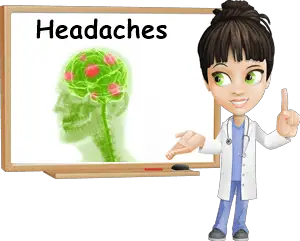Primary headaches (cephalgia) are headaches characterized by pain either in the head or neck area, or both. They are believed to be caused by a reduced blood flow to various areas of the cerebral cortex.
However, diet as well as physiological and environmental factors play a crucial part in the evolution and management of the condition. Genetics, nutritional deficiencies, injury, existing medical conditions, infection and disease may all influence outcomes.
What makes headaches problematic is the pain they cause. The resulting discomfort can be so great it interferes with daily life, affecting mood and disposition, interfering with productivity, disrupting sleep and generating mild to severe physical discomfort.
There are many contributing factors to headaches, from genetics to lack of sleep and bad dietary habits. Identifying the type of headache is also an important step in addressing it efficiently. There are several types of primary headaches, the most common of which are migraines, tension headaches and cluster headaches.

I. Migraines
Recurrent headaches characterized by pulsating pain, usually on one side of the head, and lasting more than 1-2 hours or up to 3 days are classified as migraines.
Migraines are particularly tiresome and characterized by a type of pulsating, continual pain that affects every aspect of one’s life, from sleep to work productivity.
Migraines are best investigated by a medical professional soon after they start occurring because there is a small chance they may indicate a serious underlying condition.
Other signs and symptoms accompanying migraines include:
- Sensitivity to light (photophobia), noises (phonophobia) or even smells.
- Nausea and vomiting sensation.
- Pulsating pain or throbbing usually felt on one side of the head. Often includes the eye area too.
- Blurry vision or other momentary disturbances in one’s field of vision.
Studies suggest that high levels of the neurotransmitter serotonin may also trigger migraines. This assertion is based on the fact that most medication used to treat migraines alters the binding of serotonin to various receptors. According to research, adult women are more likely to develop migraines than adult males. Also, pregnancy, use of hormonal contraception and hormone therapy are shown to increase risks. Stress is another possible triggering factor for migraines and so is lack of sleep.
However, when migraines or other types of headaches start occurring too frequently, generate debilitating pain that hinders your productivity and prevents you from carrying on with daily activities and are accompanied by symptoms such as vision problems, dizziness, loss of consciousness, nausea or vomiting, it is recommended to see a doctor as soon as possible.

II. Tension headaches
Tension headaches are headaches caused primarily by muscle tension. They can occur in the neck area, at the back of the head, around the eyes or in various parts of the head. Pain can be mild, moderate or severe and take the form of pressure, tenderness or dull pain.
Tension in the head and neck muscles
Tense muscles may result in throbbing pain on one or both sides of the head. Working at the computer all day, poor posture or inadequate working setting (example: desk too high forcing shoulders at an unnatural height too) could all trigger neck and head tension.
Eye strain (or fatigue)
Straining your eyes causes not only discomfort and alterations in your field of vision (blurry vision), but may also trigger headaches. Every 30 minutes or so, take a 2 minute break from work or studying and either keep your eyes closed and rest them or slowly inspect your surroundings to relieve eye strain.
Stress and fatigue
Stress, fatigue and improper living or working conditions are all important aspects to be taken into consideration. Stress reduction, resting, air quality, proper indoor lighting, noise reduction can contribute immensely to the prevention and better management of headaches of all types, including migraines. For example, when it comes to indoor lighting, it is recommended to avoid cool white light because it unnecessarily strains the eye and generates feeling of anxiety and tiredness. Instead, warm white light which best mimics natural sunlight is recommended.
Diet and lifestyle
Coffee and alcohol consumption causes blood vessels to constrict which consequently limits blood flow to the brain, potentially triggering a headache. Caffeinated beverages such as green tea or energy drink can have the same effect in some people.
Other causes
Other causes of tension headaches may include: fatigue, eye problems, wearing the wrong glasses, not wearing glasses, being in strong light (example: when you’re outside on a snowy day and the snow reflects the sunlight or when you’re outside on a sunny summer day without sunglasses), reading, writing or working in dim light, eye tiredness etc.
III. Cluster headaches
Cluster headaches refer to recurrent headaches usually occurring around one of the eyes, in the temple area. Pain is often hard to bear and its onset is sudden, unlike migraines where certain symptoms may come as a warning even hours before the pain installs. Although causes remain unknown, research suggests there are certain factors that help trigger cluster headaches:
- Alcohol consumption, which restricts blood flow to the brain, triggering headaches.
- Coffee and caffeine. Just like alcohol, coffee reduces blood flow to the brain, resulting in headache pain.
- Certain medication containing caffeine represents another major factor of this type of headache.
Conclusion
Overall, good dietary and lifestyle choices contribute immensely to a good management of primary headaches. Reducing stress factors, alcohol and caffeine consumption and getting enough quality sleep may help reduce headache frequency and increase your pain tolerance. Taking 2-minute breaks from work or studying, especially if it involves attentive reading, could help minimize eye strain and prevent tension headaches. Just as important, see a doctor if you experience sudden dizziness, disturbances in the field of vision, nausea, vomiting or other symptoms that are uncommon for headaches.
